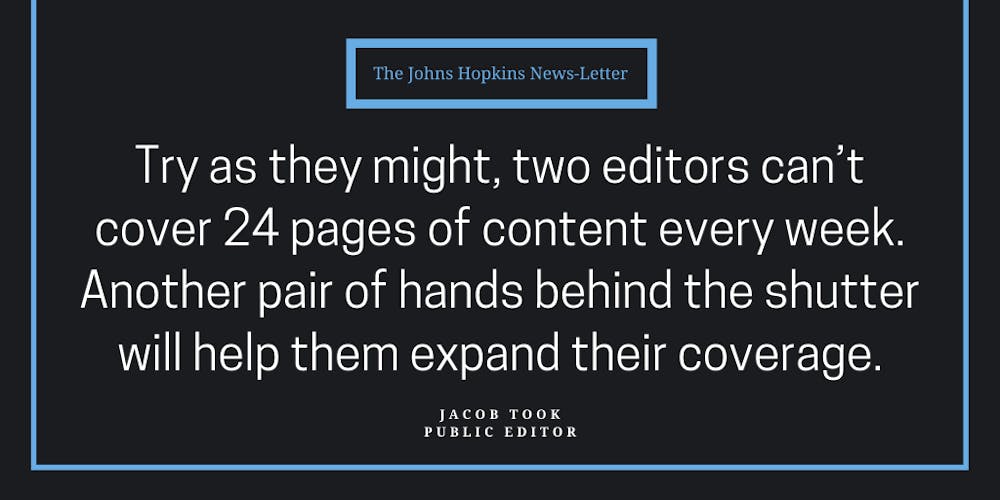
If you even casually flipped through last week’s paper, you probably noticed the stunningly striking photo essay, “Frozen land: scenes from the Swedish mountaintops.” What you may not have noticed, though, was that the photographer’s name appeared elsewhere in the issue alongside photos assigned to articles. Yes, please join me in extending a warmest welcome to the paper’s newest contributing photographer.
We should also extend a thank-you, because a look back through previous weeks makes one thing clear — try as they might, two editors can’t cover 24 pages of content every week. Another pair of hands behind the shutter will help them expand their coverage.
The proof is already in the pudding — setting aside photo essays, last week saw the first article-assigned photos from a member of the photo team appearing in print this semester. Last week included, photos from a member of the photo team account for about four percent of the photos that have appeared in the paper this year (again, that’s not including photo essays).
Now, as I mentioned, the paper fills 24 pages every week. Granted, some pages can be pretty packed with text, but in general they require at least a couple photos to break up what would otherwise be an impenetrable wall of words. So if only four percent of those come from photo editors or contributors, where do the rest come from?
The source with the largest share — about 40 percent — of News-Letter photos is our old friend, the internet.
Editors often take photos marked for reuse and pair them with articles. In some cases, this makes sense — a film review might be accompanied by a photo of the cast at the premiere. It others, it’s a grey area — news coverage of a national story typically has a Hopkins angle, but this may not always lend itself easily to visual representation. Rarely, but on occasion, it’s harder to excuse — Chipotle is right down the street, and at least one editor probably grabbed dinner there on production night, and no one could snap a quick pic?
While using a few online photos to supplement visual storytelling in The News-Letter won’t hurt in moderation, the current rate reflects a stubborn reliance that undercuts the scope of the paper’s coverage.
About 31 percent of article-assigned photos this year have come from the writers themselves. This typically means a writer took photos while reporting, but also includes writers supplementing personal columns with childhood photos or similar cases.
Reliably, though not always, weeks with a lower number of photos from writers saw an uptick of online or file photos, so bolstering the quality and consistency of photos from writers will bring down the number of online photos. Editors can get into the habit of asking writers for photos, and even encourage them to think about it early (ideally from the moment the articles are assigned). Photo editors could give a short workshop as part of staff training covering the basics — anyone going into journalism needs to know how to take a photo that’s at least usable.
I acknowledged earlier the challenge of taking on a full issue between just two editors. I hope they will continue to welcome new contributors, and know they will work hard to make the section a supportive and friendly space.
But the volume of the online photo problem will require a proactive and consistent effort to address — the photo editors should be in regular (meaning at least weekly) communication with almost section, even if they are slow to get a response at first. They need access to budgets, so that they can anticipate each section’s photo needs. If the section expands, they could consider pairing photographers with sections or beats to build more partnerships with editors.
In exchange section editors should reconsider how they can take advantage of the photo staff. Not necessarily with every piece, every week, but start somewhere — reach out to the photo editors about even one piece that would otherwise get the online photo treatment.
And while outgoing editors may be reticent to change their ways, the yearly changeover looms just a few weeks away. Training for next year’s editors must include a cohesive and firm commitment to shifting the paper’s photo habits. This could include generally discouraging editors from using any online photos, agreeing on caps that work for different sections, and identifying resources The News-Letter can take advantage of at Hopkins and in Baltimore to make photos more accessible.
I’m not just excited to see the photo section growing because I’ll get to enjoy more breathtaking photo essays like last week’s. I can’t wait to see breathtaking coverage of stuff happening on campus, of afternoons out in Baltimore and everything else the talent behind The News-Letter can cook up.
Who did The News-Letter feature in February?
The first issue of the semester saw this semester’s highest number of undergraduates, with Arts & Entertainment contributing more than usual to the overall count. That being said, after dropping off and evening out around 50, the undergrad average has remained sleepy compared to some of last fall’s more fully packed issues.
The first issue only featured two community members, both of whom appeared in one News & Features article, and the second week repeated the same numbers. The same section, however, was responsible for a sharp uptick in representation for community members in the two subsequent issues, meaning that other sections don’t typically represent this wedge of readership, despite some, like Your Weekend, having a more specific focus on interfacing between the Hopkins and Baltimore communities.
News & Features has done a great job putting more voices from the local community in front of News-Letter readers, but there are so many opportunities ahead for other sections to build out that conversation further.
We want you to be part of this conversation! We encourage our readers to email publiceditor@jhunewsletter.com with questions or comments about our practices and published content.





